Overview
The tropics are the geographic regions of the Earth centered on the equator and limited in latitude by the two tropics: the Tropic of Cancer in the north and the Tropic of Capricorn in the southern hemisphere. Tropical Flowers are those species of flowers that are native to the tropics. Tropical flowers hold a special place in the hearts of flower lovers due to their breathtaking fragrance and exquisite beauty.
Tropical gardens are no longer exclusive to tropical areas. Many gardeners in cooler climates are adopting the tropical garden design, which is possible through careful choice of plants and flowers. Main features include plants with very large leaves, vegetation that builds in height towards the back of the garden, creating a dense garden. Large plants and small trees hang over the garden, leaving sunlight to hit the ground directly.
Types Of Tropical Flowers
1. Bromeliad

Bromeliads are just as popular as beautiful foliage plants with strappy leaves in red, green, purple, orange, and yellow colors and with bands, stripes, spots, and other features. Bromeliads are relatively slow-growing plants that take one to three years to mature into flowering plants.
Most bromeliads are very adaptable and resilient house plants. Bromeliads can be either epiphytic (growing in air), saxicolous (growing on rocks), or terrestrial (growing in the ground). Most do well in pots and planters that provide good drainage and air flow.
2. Hibiscus

The shrub is fast-growing and can add up to 24 inches per year, eventually reaching heights of up 15 feet when growing under the ideal conditions. In colder climates, they are often planted as container specimens that are either replanted annually or brought indoors during the cold months.
Hibiscus has large, brightly colored, funnel-shaped flowers with prominent centers. Although tropical hibiscus blooms are profuse, each bloom usually lasts only a day or two. Flower colors of the tropical type often include shades of salmon, peach, orange or yellow, which dazzle in single or double layers of 3- to 4-inch-wide petals.
3. Clivia Miniata
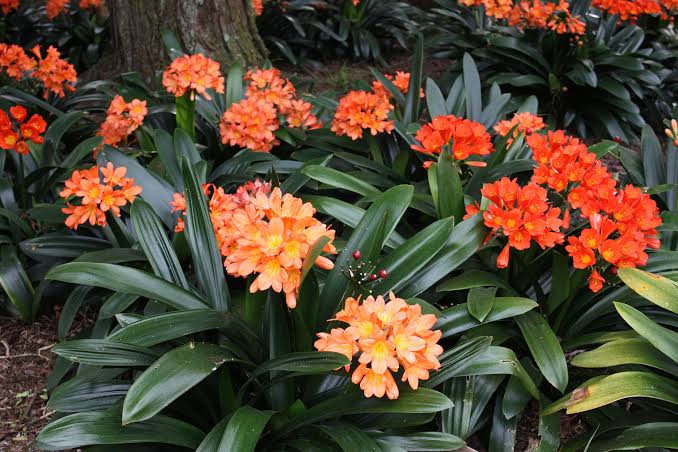
Clivia or kaffir lily (Clivia spp.) is a herbaceous flowering plant native to South Africa. Plants have long, arching, strap-like leaves (similar to an amaryllis) and produce dense clusters of trumpet-shaped flowers atop 18 to 24 inch stems. The flowers of Clivia miniata are typically orange with yellow eyes or centers. Flowers appear mainly in spring (August to November) but also sporadically at other times of the year. However, there are also several rare and expensive yellow-flowering cultivars.
While clivias are not winter hardy, they are excellent, low maintenance houseplants. Clivias grow well in any zone in containers, which can be moved indoors during winter, they live outdoors year-round in plant hardiness zones 9 through 11. Clivia plants require partial to full shade and fast-draining loamy soils to produce healthy growth.
Also Read: Types of Begonia Varieties
4. Chenille plant
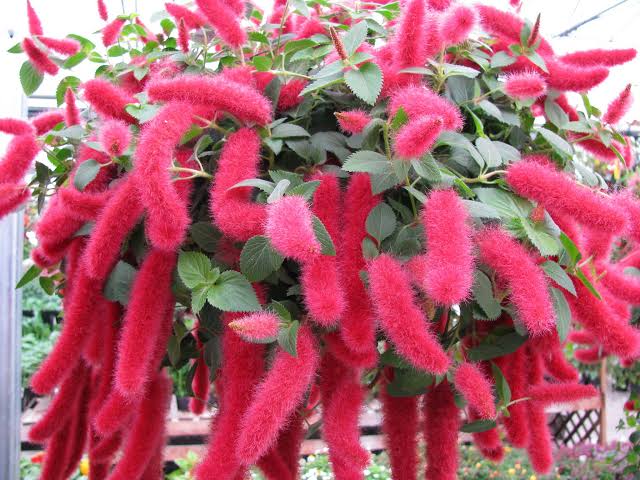
Known for its bright red, fuzzy, caterpillar-like flowers, chenille (Acalypha poiretii) is an evergreen plant commonly grown as a seasonal annual or houseplant. This evergreen plant can grow to 15 feet tall and 8 feet wide in suitable climates but in containers will remain much smaller.
Large, bright green heart-shaped leaves with toothed margins are produced on sparsely branched upright to arching stems. In tropical locations it will become a large shrub but can be maintained as a small plant by continual pruning. The long, trailing flowers of chenille make it an attractive addition to front porches and patios in hanging baskets, window boxes or planting containers.
5. Common Jasmine
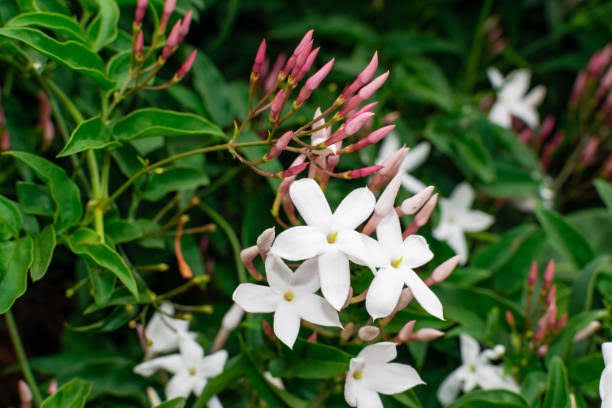
The common jasmine consists of glossy green leaves and the heady fragrance o small white flowers with heady fragrance that can perfume an entire house or garden. As a sprawling, twining deciduous vine, it can climb 20 to 30 feet high with a spread of 7 to 15 feet. The trailing branches of the arching shrub form roots as they spread. It makes an attractive ground cover on slopes.
Jasmine is best grown near a patio or window where you can enjoy its scent on summer evenings. Jasmine flowers grow in clusters, attracting bees and other pollinators from spring well into fall. Most species of the Jasmine genus are of climbing vines with delicate, fragrant flowers. The vines are low-maintenance and will even grow in full shade, although they will produce fewer flowers.
6. Bougainvillea
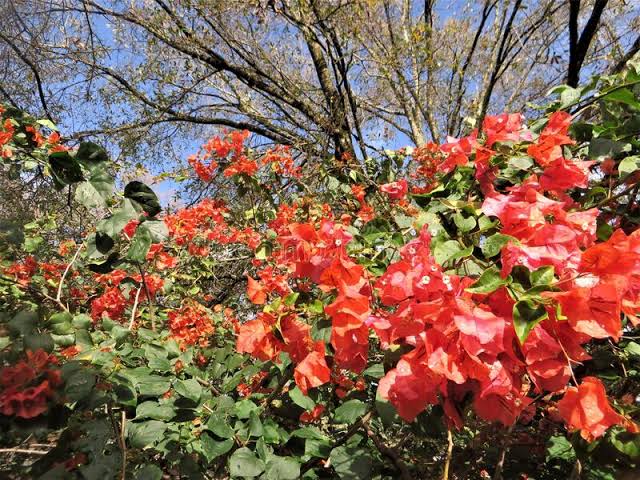
(Bougainvillea spp. and cultivars) brings masses of cascading intense warm colors to landscapes, softening and enlivening buildings, walls, fences, patios and arbors. Its rapid growth and its ability to adapt to a variety of conditions makes bougainvillea a potentially invasive plant. It can overtake a space quickly, depriving nearby plants of water and nutrients, if it is not properly maintained.
Three flowers are borne at each stem node, with flowers surrounded by three bracts, resulting in thick plant coverage with masses of color. Bract colors can be white, pale to deep pink, magenta, various shades of red, purple, mauve, lavender, gold, peach, orange, salmon and some color combinations. Colors can change as bracts age and can be deeper or paler depending on where the plant is grown.
Also Read: Types of Monstera Varieties
7. Anthuriums

The Anthurium genus contains more than 800 species of plants native to tropical rainforests. They vary in size, but they’re characterized by colorful, heart-shaped flowers and deep green, leathery foliage.The plant’s growth habits are as diverse as the species and include epiphytes, climbing hemi-epiphytes and terrestrials. Although an evergreen plant, anthuriums grow quite well in containers as houseplants or as potted outdoor plants that require indoor protection before frosts or freezes arrive.
The flowering varieties of these plants are distinctive for their multicolored spathes and red or yellow tail-like flower spikes. Other varieties feature large-leaved, deeply veined foliage. Maintaining both the plant and its flowers requires providing the anthurium with optimal growing conditions. Almost all the anthuriums are climbers and all need high humidity and warmth to thrive.
Hybrid anthuriums are available in a wealth of cultivars and yield an assortment of colorful spathes, including solid red, pink and white streaked with various colors, all with a creamy-white center spadix. The plants grow up to 2 feet tall and wide, producing bright-green, heart-shaped foliage and blooming year-round.
8. Medinilla
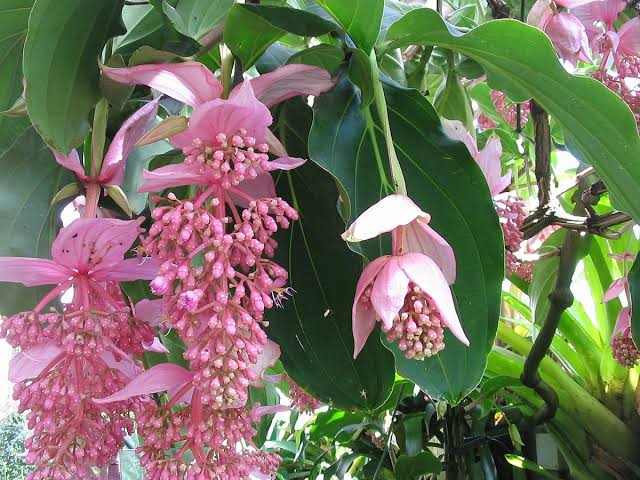
Also known as the pink lantern plant and rose grape, medinilla bears panicles of flowers that resemble clusters of small grapes, which stand out against attractive dark green foliage. Some Medinillas have showy bracts at the base of their flower clusters, which resemble flower petals.
Medinillas are evergreen shrubs in their native habitat; the leaves contribute to the tropical look of this plant, growing up to 14 inches in length. Leaves are ribbed and moderately succulent. The average size of a Medinilla shrub is 3 to 4 feet, but you can keep the plant at a reasonable indoor size by pruning it after flowering.
9. Angel’s Trumpet
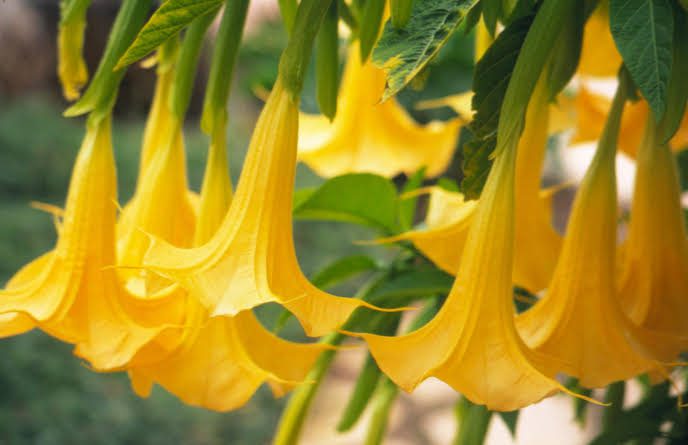
Angel’s Trumpet produces dramatic, pendant, trumpet-shaped, fragrant flowers. They can get up to 30 feet tall when grown outdoors in tropical and subtropical climates (more often 15-20 feet) but adapt well to container culture, where the plants remain a much more manageable size (4-15 feet) through pruning and root restriction.
They come in many shades of white, yellow, gold, orange, peach and pink. There are singles, doubles, triples, and quadruples and a few shredded forms, and variety of funnel and trumpet shapes. Some cultivars bloom throughout the growing season, others flower in flushes every 6-8 weeks, while some only produce flowers in cool weather. Some produce lots of flowers while others have few flowers.
10. Bird of Paradise
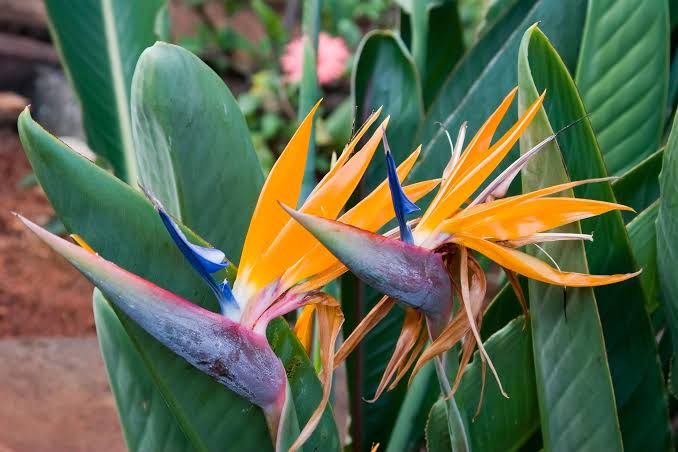
Bird of Paradise (Strelitzia reginae) gets its common name from its unusual flowers, which resemble the beak and head plumage of a bird in flight. The evergreen foliage on Bird of Paradise plants fans out to form a thick, waxy and glossy green crown. Individual leaves emerge from the soil, and are oblong and range in length from 12 to 18 inches. The simple blades are pinnate with a width of four to six inches.
Bird of paradise flowers come in sets of three to five upright orange or yellow sepals emerging from a six-inch, boat-shaped bract, along with two to three dark blue horizontal petals. Flowering occurs in late winter or early spring. Bird of Paradise type plants are popular in conservatory plantings, as specimen plants in large containers in public buildings and ornamental landscaping, and in dwarf varieties as a houseplant.
Also Read: Black-eyed Susan Varieties
11. Lily of The Nile
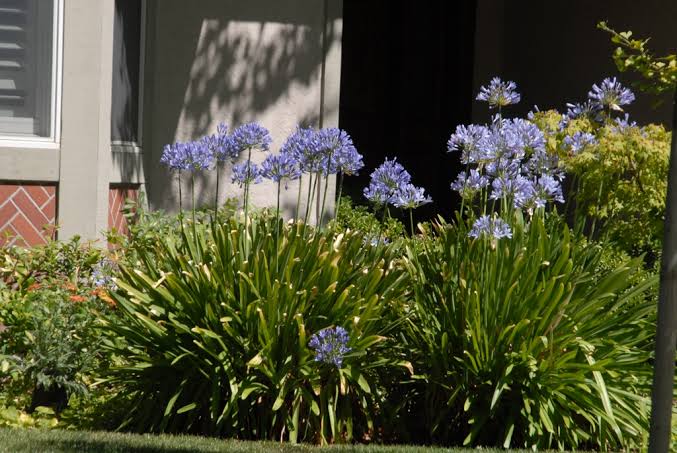
Also referred to as Agapanthus, African Lily produce rounded clusters of flowers. Each flower grouping has as many as 40 to 100 individual, tubular shaped blossoms. The leaves of the plant are deep green, with blossoms that come in a variety of hues, including pink, violet or white. The traditional color is deep violet blue.
Most bloom in late spring and continue blooming until fall, with spidery blooms attracting butterflies and bees in white to a nearly black shade of dark blue, depending on the cultivar. The plant spreads by sending out rhizomes and clumps need dividing every two or three years.
Although agapanthus thrives in the ground or in containers with little maintenance, a twice-yearly application of fertilizer promotes big, bright blooms. Planting agapanthus is an inexpensive way to improve the appearance of the landscape and may increase the value of your home.
12. Passion Flower

Passionflowers are members of the Passiflora genus, which consists of more than 500 flowering vines and shrubs. A passionflower vine grown on a trellis can grow as much as 20 feet each year and wrap their thin tendrils around structures and surrounding plants to climb upward. Passionflowers need filtered full sun or partial shade to produce the best flowers.
Passionflowers measure about 3 inches in diameter and are commonly red, purple, blue, pink, white or variegated. The exotic passionflower features five sepals, five petals, two thin rings above the reproductive organs, five stamens, three stigmas and three leaves. The exotic flowers attract a number of butterflies and insects and most species have evergreen foliage, which you can use to provide a living privacy screen in your yard.
13. Lobster Claw

Commonly called lobster claws or false birds-of-paradise, the tropical Heliconias depending upon the variety, these evergreen plants grow to heights of 2 to 15 feet and do best in part shade. The leaves of the plant resemble banana leaves and the stems are formed by a series of leaf bases.
Flowers form at the top of these stems, standing upright in some varieties and bending down in others. Flowers develop of plants once they reach maturity, about 2 years of age, and continue to flower thereafter in the spring and summer. This short-lived perennial grow from rhizomes planted in organically rich soil.
14. Maraca Ginger

In common with most plants in genus Zingiber, the leaves of the plant are long and mostly oblong shaped, tapering to a single point at their tip. Under ideal circumstances, the plant can reach a height of 4.5 meters (15 ft), or even more.
The plant’s inflorescence is set atop a spike and can measure up to 30 centimeters (12 in) in height. The bracts attached to the structure can differ in color, from white, to yellow, orange, or even red, often darkening as the bracts mature and develop. The flowers themselves are small, with purple petals and yellow spots, and a fragile, papery texture.
15. Urn Plant

Urn plant is the most popular flowering bromeliad species from the Aechmea genus. It is commonly called the silver vase or urn plant and is native to Brazil. The spiky star shaped flower head (pink in color), above the foliage – grows to approximately 6 inches long, with small violet flowers growing from the bracts.
Urns are containers with classic lines that work well when planted in matching sets to frame doorways, entryways and accent gardens. Single large plants produce a visually pleasing display for showcase plants.
Also Read: Varieties of Pothos Plants
16. Plumeria

Commonly called melia, temple tree and frangipani, the Plumeria genus contains several tropical trees native to the Caribbean and Central America. The Plumeria genus has approximately seven different species and a wide variety of cultivars. The flowers of all varieties are between 2 and 4 inches in diameter, funnel-shaped, and have five petals.
Plumeria plants vary in appearance depending on the species or cultivar. Among the most common varieties, Plumeria alba reaches heights of approximately 40 feet, while P. rubra and P. obtusa grow around 25 feet tall. P. obtusa produces 8-inch-long, medium-green, oval-shaped leaves and white blossoms with yellow interiors. This variety is evergreen, while most of the others are deciduous. P. rubra’s leaves can grow as long as 20 inches, and it produces pink or red blossoms, while P. alba has foot-long leaves and white flowers with yellow centers.
Plumeria is commonly used as a specimen tree making a fantastic impact on its own or in a tropical garden design. They’re also great in large pots in courtyards or on balconies too.
17. Amaryllis
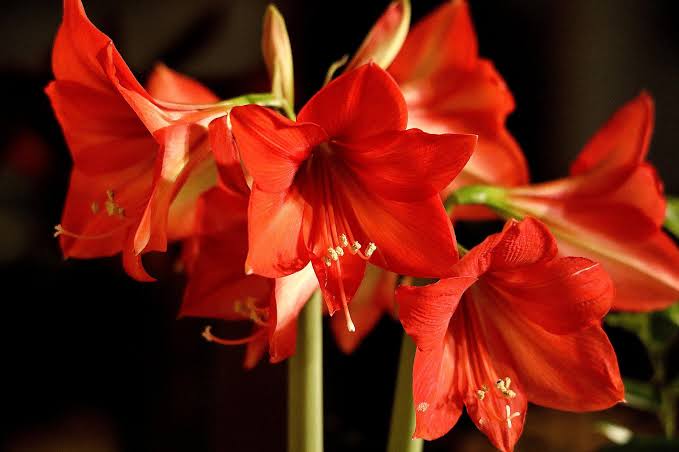
The plants commonly called amaryllis are actually members of the Hippeastrum genus, which consists of more than 50 species of bulbous, flowering plants. The true Amaryllis genus contains only one common garden plant, Amaryllis belladonna, commonly known as naked lady or belladonna lily. Belladonna lilies and amaryllis plants are quite similar in appearance, producing showy, funnel-shaped flowers and green, strap-shaped leaves.
Amaryllis plants may have single or double flowers, with petals that are frilled at the edges or striped with multiple colors. The flowers, up to 10 inches wide, top a stalk 18 to 36 inches tall and are often grown indoors to provide bright colors in a winter home.
18. Blanket Flowers

Gaillardia, also known as blanket flower, is an easy to grow, short-lived perennial that features orange, red and yellow flowers that resemble daisies in shape, often producing striking bicolored petals. Its attention-grabbing, yellow-tipped or bright-red blooms crown 2- to 3-foot stems of downy, muted-green leaves.
Gaillardia forms a slowly spreading mound and the common name may be a reference to how they can slowly spread and “blanket” an area. The flower can reseed and sprawl through the garden. Perennial blanket flowers generally bloom from early summer to early fall, but may be delayed if seeds are planted in the garden in the spring. Annual blanket flowers vary in blooming time, depending on the variety. Blooms may appear anytime from early summer to early fall.
Also Read: Calathea Zebrina Flower
19. Blood Lily
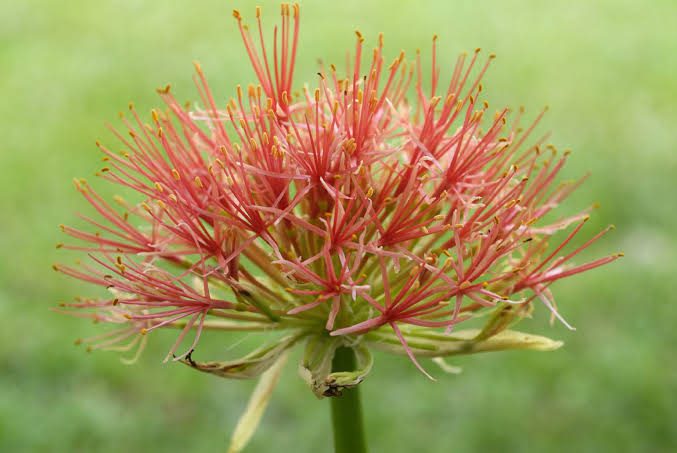
This unique plant produces large, spherical flower heads that look like red fireworks or fireballs. Made up of red, star-shaped florets with yellow-tipped stamens, these flowers explode from the landscape and attract bees, butterflies, and birds.
Each flower stem is smooth and has no foliage. Bright green semi-succulent leaves may appear while the plant is blooming, but these leaves can also appear later. Blood lily plants produce red berries in the fall.
20. Chrysanthemum Morifolium

Chrysanthemum x morifolium is the scientific name for an old-fashioned favorite commonly known as garden mum or florist’s chrysanthemum. Once known as Dendranthema x grandiflorum or chrysanthemum morifolium, this perennial autumn bloomer is a versatile plant most often used in flower beds or containers.
The long stems and big blooms, available in colors ranging from lavender and white to yellow, red and orange, make garden mums ideal for cut flower bouquets. Garden mums, which reach mature heights of 12 to 36 inches, are suitably planted in spring or autumn.
21. Orange Cosmos
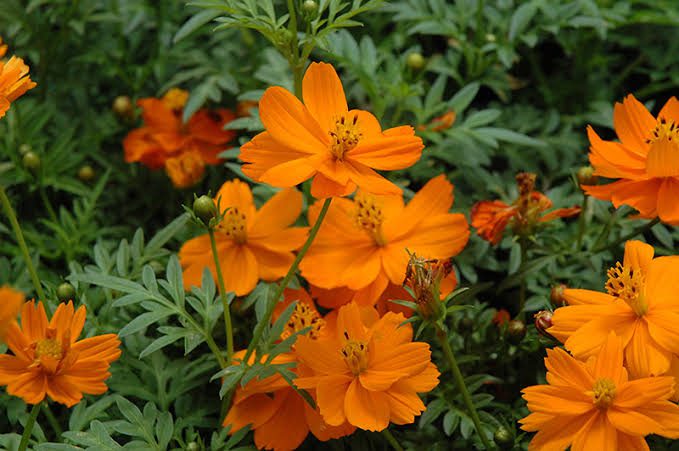
Orange cosmos, (Cosmos sulphureus), also known as yellow cosmos, is an annual that blooms from early summer to late autumn, providing abundant yellow-orange blooms with yellow centers. Orange cosmos reaches heights of up to 7 feet at maturity, but “Bright Light” and “Klondike” are shorter varieties that grow to mature heights of 3 to 4 feet.
Smaller varieties such as “Ladybird,” and “Sunny” reach heights of 1 to 1 1/2 feet, respectively. Like its cousins, the lavender, pink and white cosmos, orange cosmos is a low-maintenance plant that is often damaged by too much attention.
Also Read: Calathea Orbifolia
22. Larkspur
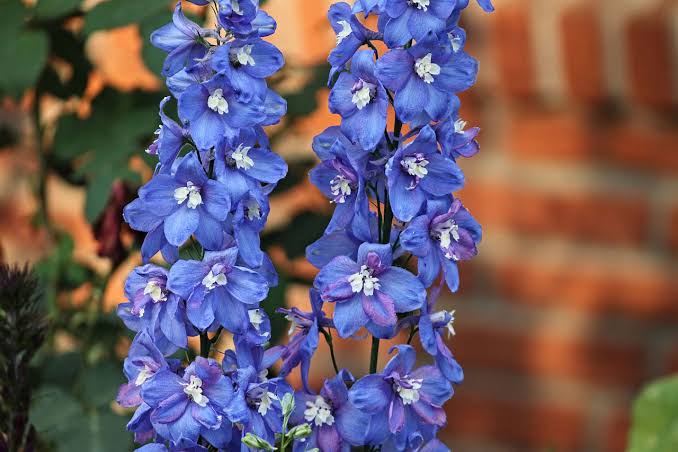
A member of the Buttercup (Ranunculaceae) family, larkspur is the common name for a group of flowering perennials in the genus Delphinium. Their flowers are in a variety of colors, including blue, lavender, white and red.Larkspur features silvery green, lobed leaves and tall, flower-covered spikes.
Depending on the variety, larkspur ranges in height from dwarf plants to plants exceeding 6 feet. Larkspur is a tender, herbaceous perennial and often must be replanted every two to three years. Larkspur prefers rich, moist, well-drained soil in full sun to partial shade.
Larkspur’s tall, colorful spires are used for cut flowers and last about one week. The flower stalks can be hung upside down and air dried for use in dried arrangements. Shorter larkspur varieties are useful in borders, rock gardens and patio containers.
23. White Bat flower

White bat flower is the common name for the Tacca integrifolia “Nivea” plant. These tropical evergreen flowers produce large white petals above drooping dark flowers and long whiskerlike bracts, which together resemble a bat face. The blossoms appear from spring through summer on top of 24- to 36-inch-tall stalks.
The white bat flower is an exotic looking, unusual plant that is somewhat difficult to grow, but rewarding for its unusual shape, texture and color in the garden. The bat flower will bloom from late spring through early fall with new blooms appearing repeatedly throughout the season.
In cooler climates, they grow best in a shady area in a hot, humid greenhouse. When raised from seed, this plant produces blooms within the same year that it sprouts.
Also Read: White Flowers
24. Cyclamen

Cyclamen are herbaceous perennials that offer nicely marked, often heart-shaped leaves and showy flowers with swept-back petals. Two commonly grown cyclamen are hardy cyclamen (Cyclamen hederifolium) and florist’s cyclamen (Cyclamen persicum). They produce bunches of tall, attractive flowers in red, pink, white and purple during the winter season.
Cyclamen grow from a tuber and can be recognized by their heart-shaped leaves. Cyclamens are often forced as indoor seasonal plants, but you can encourage future blooming by providing proper care, whether you grow them indoors or outside. These plants go dormant during the summer months, blooming only in the winter.
Further References
- Tropical flowers: https://www.trees.com/flowers/tropical-flowers#Chenille-Plant
- Examples of Tropical Flowers: https://happydiyhome.com/tropical-flowers/
- List of Tropical Flowers:https://florgeous.com/tropical-flowers/
- Varieties of Tropical Flowers: https://www.thespruce.com/tropical-flowers-you-can-grow-anywhere-4122087
- Types of Tropical Flowers: https://www.flowerglossary.com/tropical-flowers/